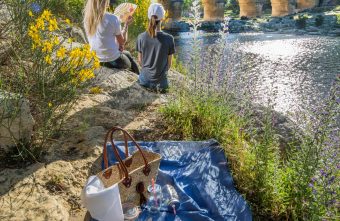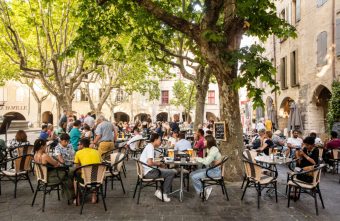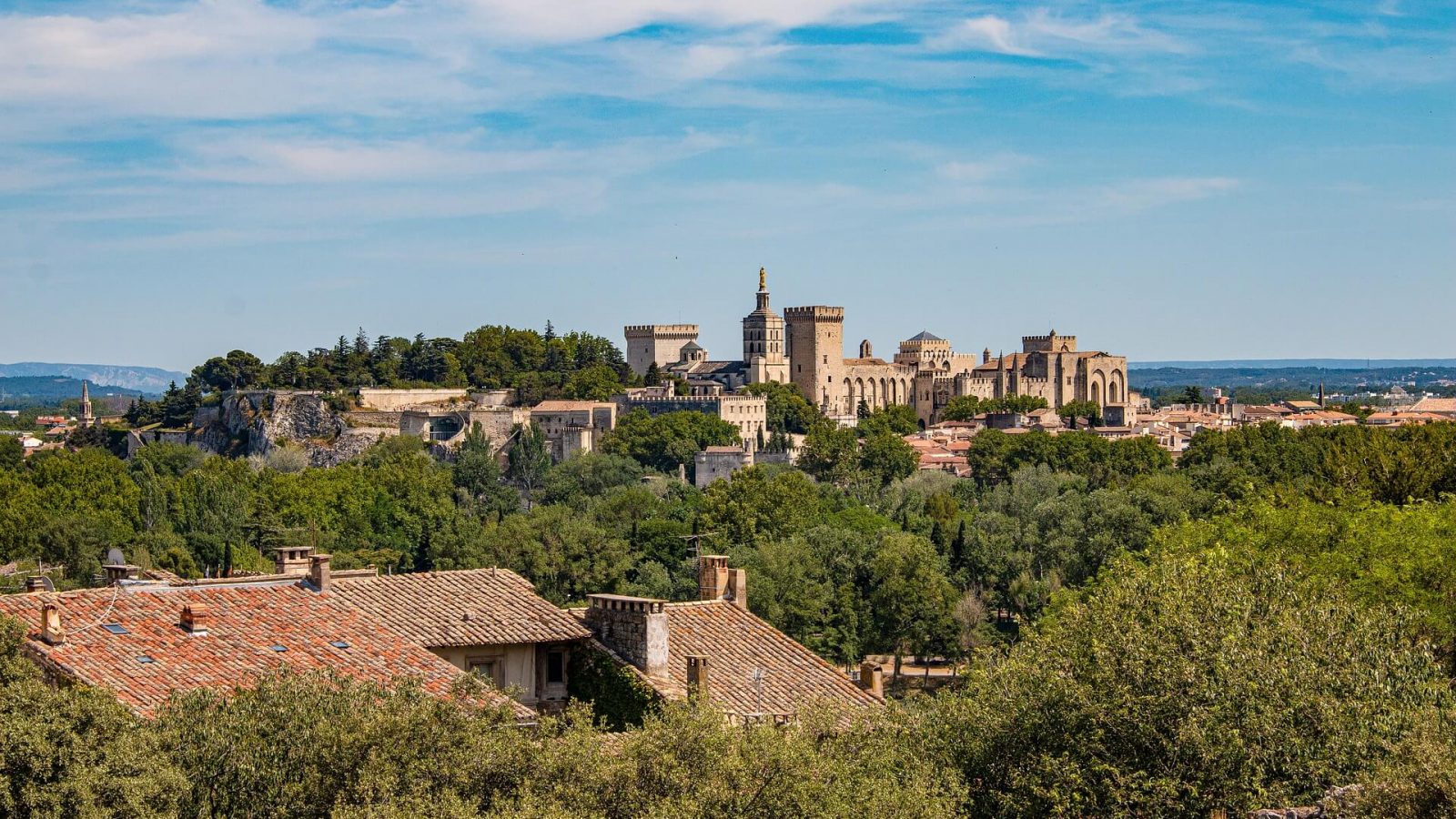Come and explore Avignon, a town with a rich and complex history. Discover the city of the Popes, the famous Pont d’Avignon and lots of other monuments… You can also experience the festive side of the town during the Festival du Théâtre that takes place every year in July.
Avignon, the city of the popes
some history
The history of Avignon began in the Neolithic era, when the very first inhabitants came to settle at the Rocher des Doms, a rocky outcrop overlooking Rhône Valley. But it was a lot later, in the Middle Ages, that the history of the town took a rather unexpected turn, when it became the chosen residence for the Popes from 1309 onwards.
At this time, the Papacy was not yet attached to the Vatican: that’s why the Popes would move around between the big towns of the pontifical states. In 1309, Clement V, a French pope who had been elected several years earlier, chose Avignon as the location for his pontificate. This was a strategic choice because the town was right on the border of the Kingdom of France.
Little by little, the papacy chose to come to Avignon, and wanted to turn it into the “new Rome”. The town became the capital of Western Christianity and nine popes resided in Avignon between 1309 and 1418.
The Palais des Papes bears witness to the town’s golden age. It was built by the various popes who reigned in Avignon, and is the biggest Gothic-style palace of the Western world. The pope would appear at one of the windows of this building to stand before the crowds of worshippers and give them his blessing.
Did you know?
Did you know? Before being elected pope under the name of Urban V, Guillaume de Grimoard was a vicar devoted to the holy bishop Saint-Firmin in Uzès!
Visiting the Palais des Papes today
25 of the rooms in this palace are open to visitors. On a tour, you can learn about the stages and techniques in building the monument and its decoration, as well as the history of the popes who reigned here and the influence they had on the town.
A part of the Palais des Papes was created by the ceramicists of Saint-Quentin-la-Poterie: you can even see some replicas of the ceramic tiles commissioned by the Papacy at the Jardin Médiéval in Uzès.
You can also visit the Jardin du Rocher des Doms, an intimate place that was used by the residents of the Pope’s apartments.
The Pont d’Avignon, the town’s landmark
Did you know? This bridge that is known across the globe thanks to the famous song, was actually named the Pont Saint-Bénézet, in honour of Saint Bénézet of Avignon, when it was built in the 12th century.
It crosses over the Rhône, an important trade route at that time, linking the papal lands to the Kingdom of France.
But where is the rest of the bridge? Today, only four arches of the bridge remain, making it look unfinished. According to scientists, the other part of the bridge collapsed because it was built onto unstable ground made up of sand and gravel. This is believed to have rendered the bridge more vulnerable to the rising waters of the Rhône river. The bridge was originally almost one kilometre long and had 22 arches in total!
And unlike in the popular children’s nursery rhyme “Sur le Pont d’Avignon”, people didn’t actually dance on the bridge, because it wasn’t wide enough, but below it, on the banks of the river.
Today, it is listed a World Heritage Site by Unesco and is open to visitors.
Explore the historic town centre
There are many other monuments in Avignon that bear witness to the town’s prestigious past. Explore the historic town centre, surrounded by medieval walls that were completed in 1370, and come and see these monuments with your own eyes.
One of the most impressive, Notre-Dame-des-Doms cathedral, overlooks the Rhône from the Rocher des Doms. This cathedral was built in the 12th century and altered in the 15th and 17th centuries, it can be easily identified thanks to its statue of the Virgin in gilded lead.

Wander the narrow streets of the town centre and take a stroll around the shops here. At the square at the heart of the town, Place Pie, there are many bars and restaurants, as well as an indoor market that is open every morning (except Mondays).
The Rue de la République is also a must-see of the town. This is the biggest of the town’s three main roads and you’ll find lots of shops here. Cross over this road to the Place de l’Horloge, where you’ll find the Tour de l’Horloge (Clock Tower).
The Rue des Teinturiers is an ancient cobbled street where you’ll be able to see the only river that crosses through the centre of Avignon. It shows the town’s economic activity thanks to the presence of the waterwheels from the former dyeworks. During Avignon’s “Festival Off”, this street is brought to life by all the restaurants and theatre productions.
While exploring the town centre, why not venture into one of the town’s many museums? There are five museums, four of which are partners with the town council! Come and visit Musée Calvet, the Musée du Petit Palais or the Collection Lambert for example.
Enjoy the town’s many events
Since 1947, the town has been holding the Festival de Théâtre d’Avignon every year in July. Created by Jean Vilar, this is one of the biggest international events for contemporary performing arts. That explains why Avignon is known as the World Theatre Capital!
Every evening in August and September, the Palais des Papes lights up: this event is called the Luminescences d’Avignon. The lights are superb and much-awaited by people of all ages!
Winter events:
- Les Hivernales, contemporary dance festival;
- Fest’Hiver, winter edition of the Festival de Théâtre d’Avignon;
- Cheval Passion, event for horse riders, breeders, professionals and horse lovers.
Explore Avignon from the waters of the Rhône
With the Rhône river passing close by, Avignon is in the ideal location for river tourism. How about treating yourself to a boat trip down the river? Aboard a riverboat or a boat-restaurant, you’ll have a relaxing experience while admiring the views all around you. A great experience as a family or with friends!
Visit Villeneuve-lès-Avignon
On the other side of the Rhône, Villeneuve-lès-Avignon is also brimming with history. From 1353, during the reign of pope Innocent VI, the Carthusian order, one of the biggest in the Middle Ages, came to reside here. The Chartreuse Notre-Dame-du-Val-de-Bénédiction was built for these worshippers.
Even today, visitors are still struck by the feeling of peace and tranquility that you get at this place of worship.
The Fort Saint-André, overlooking Villeneuve-lès-Avignon, was built by the Kings of France to assert their power in this town reigned by the popes. In visiting this remarkable example of 14th-century architecture, you’ll be able to admire a panoramic view of Avignon and the surrounding area.

Inside the enclosure of the Fort is the Abbey of Saint-André, and the superb gardens are also open to visitors.
The Tour Philippe Le Bel, built on a rocky outcrop, was the keep for a fortress built in the 13th century by the King of France known as “Philippe Le Bel” (Philip the Fair). From this tower, it was possible to reach Avignon across the Pont Saint-Bénézet, now well-known across the world as the “Pont d’Avignon”.
You now know (almost) all the secrets of the town!
 Ticketing
Ticketing  Pass
Pass
 Gift box
Gift box  Groups & business
Groups & business 


















